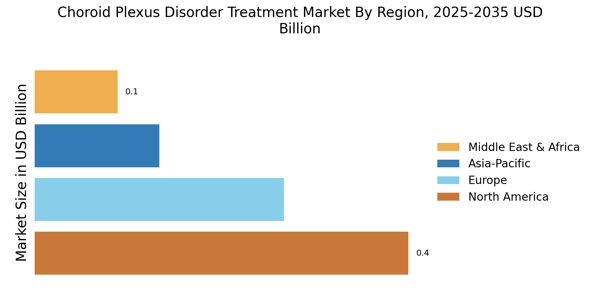Rising Incidence of Neurological Disorders
The increasing prevalence of neurological disorders, including those affecting the choroid plexus, is a primary driver of the Choroid Plexus Disorder Treatment Market. As the population ages, the incidence of conditions such as hydrocephalus and other related disorders is expected to rise. According to recent estimates, neurological disorders affect millions worldwide, leading to a growing demand for effective treatment options. This trend is likely to stimulate investment in research and development, thereby enhancing the treatment landscape. Furthermore, the rising awareness of these disorders among healthcare professionals and patients is expected to contribute to market growth. The need for innovative therapies and improved patient outcomes is becoming increasingly apparent, which may drive the expansion of the Choroid Plexus Disorder Treatment Market.
Regulatory Support for Innovative Therapies
Regulatory support for innovative therapies is emerging as a vital driver in the Choroid Plexus Disorder Treatment Market. Regulatory agencies are increasingly recognizing the need for expedited approval processes for breakthrough therapies aimed at treating rare and complex disorders. This supportive environment encourages pharmaceutical companies to invest in the development of new treatments for choroid plexus disorders. Additionally, initiatives aimed at fostering collaboration between regulatory bodies and industry stakeholders are likely to enhance the speed at which new therapies reach the market. As a result, the Choroid Plexus Disorder Treatment Market may witness accelerated growth, driven by the introduction of innovative treatment options.
Increased Awareness and Education Initiatives
The rise in awareness and education initiatives surrounding choroid plexus disorders is a crucial driver for the Choroid Plexus Disorder Treatment Market. Healthcare organizations and advocacy groups are actively promoting knowledge about these conditions, leading to earlier diagnosis and treatment. This heightened awareness is likely to result in increased patient referrals and consultations, thereby expanding the market. Furthermore, educational programs aimed at healthcare professionals are enhancing their understanding of these disorders, which may lead to improved treatment protocols. As more patients seek help for symptoms related to choroid plexus disorders, the demand for effective treatment options is expected to grow, positively impacting the Choroid Plexus Disorder Treatment Market.
Growing Investment in Research and Development
The surge in investment in research and development is a significant factor propelling the Choroid Plexus Disorder Treatment Market. Pharmaceutical companies and research institutions are increasingly allocating resources to explore novel therapeutic approaches for treating choroid plexus disorders. This investment is likely to lead to the discovery of new drugs and treatment strategies, enhancing the overall treatment landscape. Moreover, government funding for neurological research is on the rise, which may further stimulate innovation in this field. As a result, the Choroid Plexus Disorder Treatment Market is poised for growth, driven by the continuous pursuit of effective and targeted therapies.
Technological Advancements in Treatment Modalities
Technological innovations in treatment modalities are significantly influencing the Choroid Plexus Disorder Treatment Market. The development of minimally invasive surgical techniques and advanced imaging technologies has revolutionized the approach to treating choroid plexus disorders. For instance, endoscopic procedures have gained traction, allowing for more precise interventions with reduced recovery times. Additionally, the integration of artificial intelligence in diagnostic tools is enhancing the accuracy of disease detection and treatment planning. These advancements not only improve patient outcomes but also attract investment from pharmaceutical companies and healthcare providers. As a result, the Choroid Plexus Disorder Treatment Market is likely to experience growth driven by the adoption of these cutting-edge technologies.


















Leave a Comment